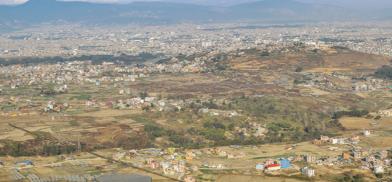Kathmandu breathes cleaner air during lockdown
Aasha Jha becomes very happy every time she goes to the roof of her house in Tahagalli, Lalitpur Metropolitan City–8, these days. Ever since the lockdown began, she has been able to clearly see the airport from her terrace

Kathmandu: Aasha Jha becomes very happy every time she goes to the roof of her house in Tahagalli, Lalitpur Metropolitan City–8, these days. Ever since the lockdown began, she has been able to clearly see the airport from her terrace.
“Usually haze and smog block the view but the air has cleared up since the lockdown began and I am able to see far and wide,” she said.
Buddhi Lal Maharjan has also noticed a change in air quality during his regular morning walks around Balkumari, Lalitpur. “The atmosphere feels purer,” he said. “On regular days, it is stuffy and difficult to breathe in the mornings but since the lockdown, the air has become cleaner,” he said.
Jha and Maharjan’s feelings are supported by Kathmandu’s Air Quality Index (AQI), which has significantly improved since the lockdown was imposed on March 24.
On Tuesday, Kathmandu’s AQI was 85 (classified as moderate), as measured at Phora Durbar by the air quality monitor installed by the United States (US) Embassy in Kathmandu. This is a dramatic improvement from normal days when Kathmandu’s AQI ranges between 150 and 180 (classified as unhealthy). Kathmandu’s air has objectively become healthier.
And according to Environmental Expert Bhushan Tuladhar, this is because of three main factors – reduction in traffic, frequent rains and the westerly winds.
“Vehicles are a major source of pollution in the valley, emitting smoke and harmful gases. And since the lockdown has kept them off the road, air quality has improved,” he said.
Along with the reduction in traffic, Tuladhar stressed that the natural processes, namely frequent rains and westerly winds, have also played a big role in cleaning the capital’s air.
“Pollution levels had started to rise around two weeks ago on April 11 and 12 because of the numerous forest fires in the areas surrounding the Kathmandu Valley and the air had, once again, become unhealthy. But then we got the rains,” he said.
Raindrops often tend to attract tiny aerosol particles to their surface while falling to the ground. This serves to clear the air of pollutants like soot, sulphates and organic particles.
But, sooner or later, the lockdown will be lifted, the vehicles will return and so will the pollution. Kathmandu’s air will once again become unhealthy to breathe and the smog will once again engulf the valley.
In fact, things might even become worse than before. As Tuladhar explained, people will try to avoid the crammed and crowded public transportation in the aftermath of COVID-19 and will choose to take their private cars and motorbikes instead. This will put more vehicles on the road which means more pollution.
This is especially worrying in light of a new study conducted in the US by researchers at the Harvard University T.H. Chan School of Public Health. The study established a clear link between pollution and COVID-19 and found that exposure to polluted air significantly increased people’s chances of developing a serious respiratory disease like COVID-19. Research from China during the 2003 SARS outbreak, caused by a different coronavirus strain, had also established similar links.
According to Dr Dibasha Adhikari, medical officer at Patan Hospital, this is because breathing in polluted air can compromise the health of people’s lungs – the primary organ attacked by the coronavirus.
So, we are stuck in a vicious loop. COVID-19 pushes people to opt for private vehicle that increases pollution which then increases COVID-19 infections and the cycle continues. That is why we must find a sustainable solution to pollution in Kathmandu and the whole country, which, according to Tuladhar, would be to increase the walking space in our urban areas.
“We must promote pedestrianization, which is about increasing the walking space and decreasing the space for vehicles in our cities,” explained Tuladhar. “This is possible very easily in Kathmandu as our average daily travel distance is just 5 kilometres which can be covered on foot.”
He gave the example of cities like Paris and Brussels and countries like New Zealand that have embraced this concept of car-free towns and are now seeing positive results. He said, “Not only is it good for the environment, but studies have shown it also boosts local businesses.”
He also advocated for the creation of cycle lanes on roads and the wider promotion of cycling as a sustainable means of transport and also called for the electrification of public vehicles.
https://risingnepaldaily.com/main-news/kathmandu-breathes-cleaner-air-during-the-lockdown








Post a Comment